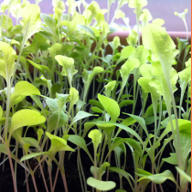How to Grow Baby Romaine or Cos – Growing Microgreens at Home

We all know eating more locally-grown lettuce is good both for you and the environment. However, depending on the season and your whereabouts, you may have trouble finding locally-produced fresh lettuce at grocery stores and farmers' markets. One way to overcome this issue is to set up an indoor 'garden' for growing miniature salad greens, such as baby romaine lettuce (also known as baby cos), which is harvested when the greens are just a few inches tall. All you need is a sunny windowsill, a grow light (optional but recommended), organic potting soil, and some romaine lettuce seeds. It doesn't matter whether you choose a green and red romaine cultivar, both will yield delicious baby greens. To help budding indoor gardeners to grow their first crop of baby romaine, HealWithFood.org put together these step-by-step instructions:
1. Buying seeds. Buy certified organic romaine or cos lettuce seeds. Common romaine varieties include Parris Island Cos, Valmaine, and Little Gem.
2. Creating a miniature indoor garden. Create an indoor seed bed by filling a shallow tray with nutrient-rich potting mix. Break up any large soil clumps and smooth out the soil surface. Sow romaine seeds evenly over the potting soil.
3. Finding a place for the tray. Next, place the tray on a sunny windowsill. Romaine is a cool weather crop, so don't worry if the windowsill is not very warm. If you plan to harvest your romaine at the microgreen stage (when the young seedlings have just emerged from the soil), a sunny windowsill will usually provide enough light. If you're looking to grow slightly larger baby romaine greens, you may want to buy a compact fluorescent grow light to ensure the seedlings get enough sun to produce a good crop.
4. Watering growing baby romaine. Be sure to give your emerging romaine microgreens or baby greens enough water. Moisten the soil with cool water using a spray bottle or a watering can with fine holes. Be careful not to overwater the soil, though. If you let lettuce seedlings sit in water, their roots will soon begin to rot, and your entire crop may be ruined.
5. Harvesting. When your baby romaine greens have reached the desired size, cut them close to the soil level with sharp scissors. To minimize nutrient loss, enjoy your miniature romaine leaves right after harvesting. You can juice them or add them to green smoothies, salads, cold soups, and sandwiches.

